作为主题的制作者, 除了实现功能, 展示界面, 还有责任使主题灵活多变, 以满足更多人不同的需求.
可能一些朋友曾为选用双栏主题 (单侧边栏) 还是三栏主题 (双侧边栏) 而烦恼过. 下面我们以 classic 主题为例, 谈谈如何在主题中方便地切换单侧边栏和双侧边栏. 最后我会提供修改后的主题.
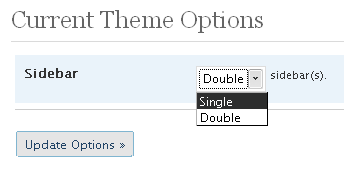 爱主机评测网,最优惠主机信息推荐,便宜VPS分享,香港CN2
爱主机评测网,最优惠主机信息推荐,便宜VPS分享,香港CN2
添加管理选项
后台处理
首先, 我们要修改 function.php, 主要的处理工作都在这个文件里面, 如果主题没有这个文件, 就创建一个吧. (没有 function.php 说明主题不支持 widget, 可不是一个好习惯哦, 还是赶紧新建一个吧)
我的处理包括 3 大块: 获取选项, 初始化, 标签页操作界面. 这里只创建一个公告栏, 包括两个选项 (是否显示公告栏和公告栏内容). 如果要添加更多选项, 也只需要代码中 3 个 todo 的位置上追加一些代码而已. 当然, 你还需要改一下选项名称, 将 classic 和 classic 全部之换掉.
|
1
2
3
4
5
6
7
8
9
10
11
12
13
14
15
16
17
18
19
20
21
22
23
24
25
26
27
28
29
30
31
32
33
34
35
36
37
38
39
40
41
42
43
44
45
46
47
48
49
50
51
52
53
54
55
56
57
58
59
60
62
63
64
65
66
67
68
69
70
71
72
73
74
75
76
77
78
79
80
81
82
83
84
85
86
87
88
89
90
91
92
93
94
95
96
97
98
99
100
101
102
103
104
|
<?php/** * 选项组类型 */class classicoptions { /* -- 获取选项组 -- */ // 在数据库中获取选项组 $options = get_option('classic_options'); // 如果数据库中不存在该选项组, 设定这些选项的默认值, 并将它们插入数据库 if (!is_array($options)) { $options['notice'] = false; $options['notice_content'] = ''; // todo: 在这里追加其他选项 update_option('classic_options', $options); } // 返回选项组 return $options; } /* -- 初始化 -- */ function init() { // 如果是 post 提交数据, 对数据进行限制, 并更新到数据库 if(isset($_post['classic_save'])) { // 获取选项组, 因为有可能只修改部分选项, 所以先整个拿下来再进行更改 // 数据限制 if ($_post['notice']) { $options['notice'] = (bool)true; } else { $options['notice'] = (bool)false; } $options['notice_content'] = stripslashes($_post['notice_content']); // todo: 在这追加其他选项的限制处理 // 更新数据 update_option('classic_options', $options); // 否则, 重新获取选项组, 也就是对数据进行初始化 } else { classicoptions::getoptions(); } // 在后台 design 页面追加一个标签页, 叫 current theme options add_theme_page("current theme options", "current theme options", 'edit_themes', basename(__file__), array('classicoptions', 'display')); } /* -- 标签页 -- */ function display() { $options = classicoptions::getoptions();?> <form action="#" method="post" enctype="multipart/form-data" name="classic_form" id="classic_form"> <div class="wrap"> <h2><?php _e('current theme options', 'classic'); ?></h2> <!-- 公告栏 --> <table class="form-table"> <tbody> <tr valign="top"> <th scope="row"> <?php _e('notice', 'classic'); ?> <br/> </th> <td> <!-- 是否显示公告栏 --> <label> <input name="notice" type="checkbox" value="checkbox" <?php if($options['notice']) echo "checked='checked'"; ?> /> <?php _e('show notice.', 'classic'); ?> </label> <br/> <!-- 公告栏内容 --> <label> <textarea name="notice_content" cols="50" rows="10" id="notice_content" style="width:98%;font-size:12px;" class="code"><?php echo($options['notice_content']); ?></textarea> </label> </td> </tr> </tbody> </table> <!-- todo: 在这里追加其他选项内容 --> <!-- 提交按钮 --> <p class="submit"> <input type="submit" name="classic_save" value="<?php _e('update options »', 'classic'); ?>" /> </p> </div> </form> <?php }} /** * 登记初始化方法 */add_action('admin_menu', array('classicoptions', 'init')); ?> |
前台处理
要公告栏在首页上显示, 需要修改一下 index.php, 这个比较简单, 只是通过一些判断语句决定东西要不要显示出来而已. 当然, 你可以进行其他操作, 关键是获取到选项的值, 并对它们进行处理.
其实可以分为两步:
获取选项 (对每个 php 文件, 获取一次就行了, 可以在文件顶部执行)
对选项进行处理 (这里判断成立的话就将公告内容显示出来)
|
1
2
3
4
5
6
7
8
9
|
<!-- 获取选项 --><?php $options = get_option('classic_options'); ?> <!-- 如果用户选择显示公告栏, 并且公告栏有内容, 则显示出来 --><?php if($options['notice'] && $options['notice_content']) : ?> <div id="notice"> <div class="content"><?php echo($options['notice_content']); ?></div> </div><?php endif; ?> |
可以使用管理项来控制侧边栏的数量, 在主题文件中获取侧边栏的数量, 对不同的数量作出不同的处理, 以达到在不同数量侧边栏之间切换的目的.
|
1
2
3
4
5
6
7
8
9
10
11
|
// 侧边栏数量, 默认为单侧边栏$options['sidebar'] = 1;// 获得最新提交的值$options['sidebar'] = $_post['sidebar'];<select name="sidebar" size="1"> <!-- 单侧边栏 --> <option value="1" <?php if($options['sidebar'] != 2) echo ' selected '; ?>><?php _e('single', 'classic'); ?></option> <!-- 双侧边栏 --> <option value="2" <?php if($options['sidebar'] == 2) echo ' selected '; ?>><?php _e('double', 'classic'); ?></option></select> <?php _e('sidebar(s)', 'classic'); ?>. |
添加 widget 支持
因为要在单侧边栏和双侧边栏中切换, 所以我们需要对不同的两种模式定义两个 widget 初始化的分支.
这里比较特殊, 为了在代码中正确获取 widget 信息, 就算是单侧边栏也需要起一个别名. 就像代码中的 sidebar_single. 当侧边栏个数为 1 时, 登记 sidebar_single. 当侧边栏个数为 2 时, 登记 sidebar_top 和 sidebar_bottom.
|
1
2
3
4
5
6
7
8
9
10
11
12
13
14
15
16
17
18
19
20
21
22
23
24
25
26
27
28
29
30
|
// widgets$options = get_option('classic_options'); // 单侧边栏if(function_exists('register_sidebar') && $options['sidebar'] == 1) { register_sidebar(array( 'name' => 'sidebar_single', 'before_widget' => '<li id="%1$s" class="widget %2$s">', 'after_widget' => '</li>', 'before_title' => '<h3>', 'after_title' => '</h3>' )); // 双侧边栏} else if(function_exists('register_sidebar') && $options['sidebar'] == 2) { register_sidebar(array( 'name' => 'sidebar_bottom', 'before_widget' => '<li id="%1$s" class="widget %2$s">', 'after_widget' => '</li>', 'before_title' => '<h3>', 'after_title' => '</h3>' )); register_sidebar(array( 'name' => 'sidebar_top', 'before_widget' => '<li id="%1$s" class="widget %2$s">', 'after_widget' => '</li>', 'before_title' => '<h3>', 'after_title' => '</h3>' ));} |
修改侧边栏结构
首先要明确, 我们现在需要双侧边栏结构. 怎样将双侧边栏变为单侧边栏呢? 只要将前一个侧边栏的结束标签和后一个侧边栏的开始标签删除, 两个侧边栏就合并为一个侧边栏了. 单纯的文字很难将我的想法和实现表达出来, 你可以接着看下面的代码和示例图片.
|
1
2
3
4
5
6
7
8
9
10
11
12
13
14
15
16
17
18
|
<ul class="sidebar_1"> <?php if ( !function_exists('dynamic_sidebar') || !dynamic_sidebar('sidebar_single') ) : // single ?> <?php if ( !function_exists('dynamic_sidebar') || !dynamic_sidebar('sidebar_top') ) : // top ?><!-- todo: 顶部侧边栏内容 --> <?php endif; // top ?> <?php if ($options['sidebar'] >= 2) : ?></ul><ul class="sidebar_2"> <?php endif; ?> <?php if ( !function_exists('dynamic_sidebar') || !dynamic_sidebar('sidebar_bottom') ) : // bottom ?><!-- todo: 底部侧边栏内容 --> <?php endif; // bottom ?> <?php endif; // single ?></ul> |
ok, 这就是侧边栏代码结构了. 它可以完美得实现单双侧边栏间的切换. 但它是怎么工作的呢? 我将在后面用图片列出它的 6 种可能出现的状态.
因为主题已经支持 widget 了, 所以代码中 function_exists('dynamic_sidebar') === true, 则 !function_exists('dynamic_sidebar') === false.
记得添加 widget 支持时写的代码吗? 侧边栏为 1 时 sidebar_single 有效, 侧边栏为 2 时, sidebar_top 和 sidebar_bottom 有效. 这是贯穿整个思路的关键.
备注:
- 红色: 表示选中代码的值是 false, 不通过
- 绿色: 表示选中代码的值是 true, 通过
- 蓝色: 表示选中部分将被选用的 widgets 所取代
- 灰色: 表示选中部分代码将会失效
状态一: 单侧边栏, 没使用 widget
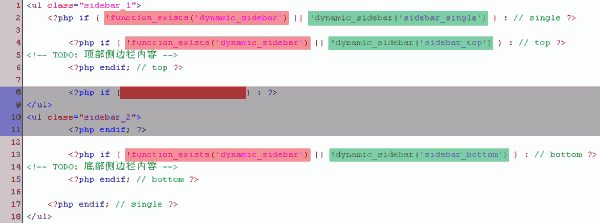
状态二:双侧边栏, 没使用 widget
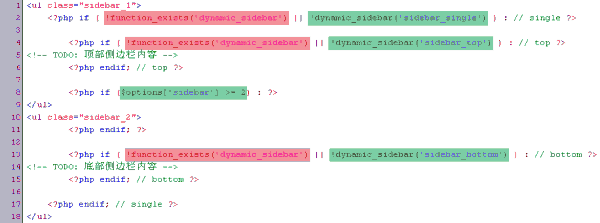
状态三: 单侧边栏, 使用 widget
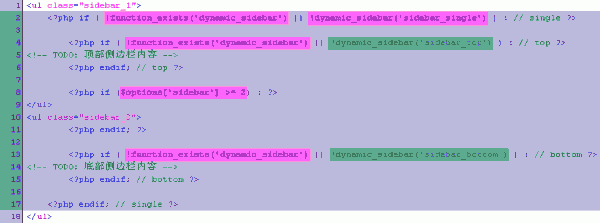
状态四: 双侧边栏, 顶部侧边栏使用 widget
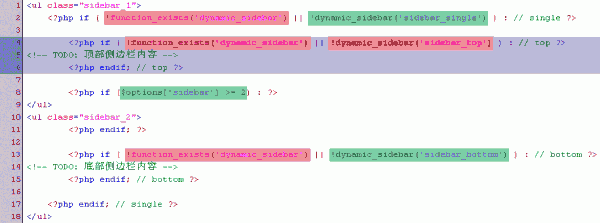
状态五: 双侧边栏, 底部侧边栏使用 widget
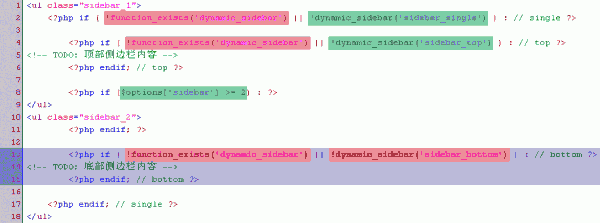
状态六: 双侧边栏, 顶部和底部侧边栏都使用 widget
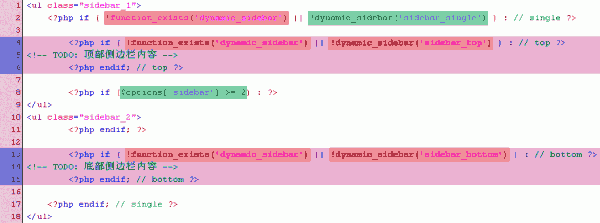
 爱主机
爱主机

